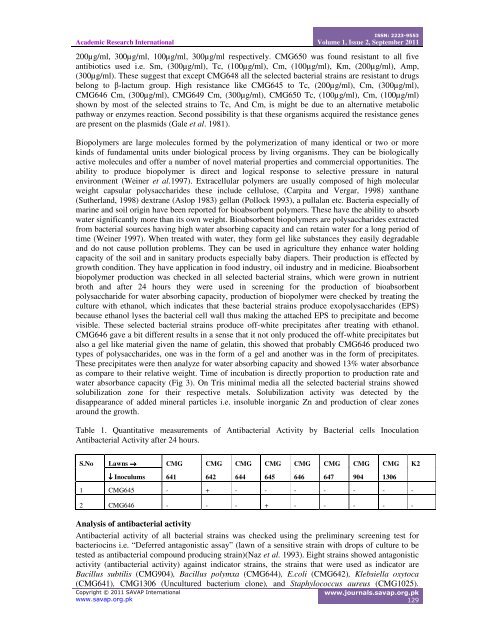Vol. 1(2) SEP 2011 - SAVAP International
Vol. 1(2) SEP 2011 - SAVAP International
Vol. 1(2) SEP 2011 - SAVAP International
You also want an ePaper? Increase the reach of your titles
YUMPU automatically turns print PDFs into web optimized ePapers that Google loves.
Academic Research <strong>International</strong><br />
ISSN: 2223-9553<br />
<strong>Vol</strong>ume 1, Issue 2, September <strong>2011</strong><br />
200µg/ml, 300µg/ml, 100µg/ml, 300µg/ml respectively. CMG650 was found resistant to all five<br />
antibiotics used i.e. Sm, (300µg/ml), Tc, (100µg/ml), Cm, (100µg/ml), Km, (200µg/ml), Amp,<br />
(300µg/ml). These suggest that except CMG648 all the selected bacterial strains are resistant to drugs<br />
belong to β-lactum group. High resistance like CMG645 to Tc, (200µg/ml), Cm, (300µg/ml),<br />
CMG646 Cm, (300µg/ml), CMG649 Cm, (300µg/ml), CMG650 Tc, (100µg/ml), Cm, (100µg/ml)<br />
shown by most of the selected strains to Tc, And Cm, is might be due to an alternative metabolic<br />
pathway or enzymes reaction. Second possibility is that these organisms acquired the resistance genes<br />
are present on the plasmids (Gale et al. 1981).<br />
Biopolymers are large molecules formed by the polymerization of many identical or two or more<br />
kinds of fundamental units under biological process by living organisms. They can be biologically<br />
active molecules and offer a number of novel material properties and commercial opportunities. The<br />
ability to produce biopolymer is direct and logical response to selective pressure in natural<br />
environment (Weiner et al.1997). Extracellular polymers are usually composed of high molecular<br />
weight capsular polysaccharides these include cellulose, (Carpita and Vergar, 1998) xanthane<br />
(Sutherland, 1998) dextrane (Aslop 1983) gellan (Pollock 1993), a pullalan etc. Bacteria especially of<br />
marine and soil origin have been reported for bioabsorbent polymers. These have the ability to absorb<br />
water significantly more than its own weight. Bioabsorbent biopolymers are polysaccharides extracted<br />
from bacterial sources having high water absorbing capacity and can retain water for a long period of<br />
time (Weiner 1997). When treated with water, they form gel like substances they easily degradable<br />
and do not cause pollution problems. They can be used in agriculture they enhance water holding<br />
capacity of the soil and in sanitary products especially baby diapers. Their production is effected by<br />
growth condition. They have application in food industry, oil industry and in medicine. Bioabsorbent<br />
biopolymer production was checked in all selected bacterial strains, which were grown in nutrient<br />
broth and after 24 hours they were used in screening for the production of bioabsorbent<br />
polysaccharide for water absorbing capacity, production of biopolymer were checked by treating the<br />
culture with ethanol, which indicates that these bacterial strains produce exopolysaccharides (EPS)<br />
because ethanol lyses the bacterial cell wall thus making the attached EPS to precipitate and become<br />
visible. These selected bacterial strains produce off-white precipitates after treating with ethanol.<br />
CMG646 gave a bit different results in a sense that it not only produced the off-white precipitates but<br />
also a gel like material given the name of gelatin, this showed that probably CMG646 produced two<br />
types of polysaccharides, one was in the form of a gel and another was in the form of precipitates.<br />
These precipitates were then analyze for water absorbing capacity and showed 13% water absorbance<br />
as compare to their relative weight. Time of incubation is directly proportion to production rate and<br />
water absorbance capacity (Fig 3). On Tris minimal media all the selected bacterial strains showed<br />
solubilization zone for their respective metals. Solubilization activity was detected by the<br />
disappearance of added mineral particles i.e. insoluble inorganic Zn and production of clear zones<br />
around the growth.<br />
Table 1. Quantitative measurements of Antibacterial Activity by Bacterial cells Inoculation<br />
Antibacterial Activity after 24 hours.<br />
S.No Lawns → CMG CMG CMG CMG CMG CMG CMG CMG K2<br />
↓ Inoculums 641 642 644 645 646 647 904 1306<br />
1 CMG645 - + - - - - - - -<br />
2 CMG646 - - - + - - - - -<br />
Analysis of antibacterial activity<br />
Antibacterial activity of all bacterial strains was checked using the preliminary screening test for<br />
bacteriocins i.e. “Deferred antagonistic assay” (lawn of a sensitive strain with drops of culture to be<br />
tested as antibacterial compound producing strain)(Naz et al. 1993). Eight strains showed antagonistic<br />
activity (antibacterial activity) against indicator strains, the strains that were used as indicator are<br />
Bacillus subtilis (CMG904), Bacillus polymxa (CMG644), E.coli (CMG642), Klebsiella oxytoca<br />
(CMG641), CMG1306 (Uncultured bacterium clone), and Staphylococcus aureus (CMG1025).<br />
Copyright © <strong>2011</strong> <strong>SAVAP</strong> <strong>International</strong><br />
www.savap.org.pk<br />
www.journals.savap.org.pk<br />
129

















